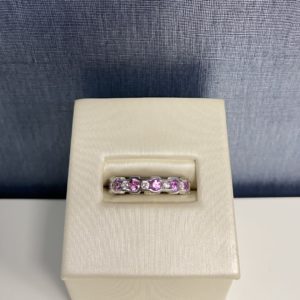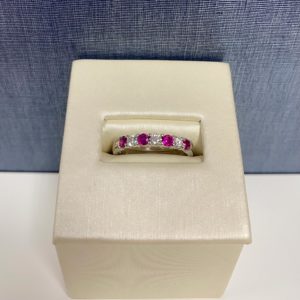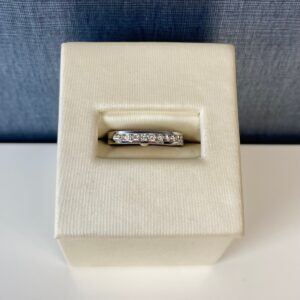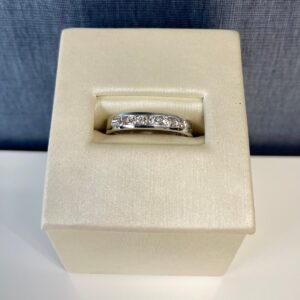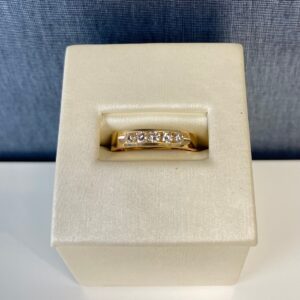Showing all 5 results
The term “carat” refers to the weight and size of a diamond. The value of a diamond rises exponentially with its size. Most diamonds fall in between 0.01 carat and 1.00 in size. Put another way, that range is between a hundredth of a carat and a full carat in weight.
Carat Weight
Carat is the unit in which a diamond is weighed. One carat equals 0.2 grams or 200 milligrams. Carat weight is the prime factor that determines the weight of a diamond. Larger diamonds are undoubtedly costlier. Carat makes expressing diamond weight easier as compared to milligrams. Instead of giving three labels to diamonds weighing 20 milligrams, 211 milligrams and 220 milligrams, carat offers a category for fitting the diamonds in a one category, placing these diamonds in one-carat range.

One should not forget that high carat weight does not necessarily mean a larger looking diamond. Even diamonds of the same weight can differ on a basis of other factors, especially cuts that influence perceived size. Large diamonds are rare to find and much in demand as compared to small diamonds even of the same quality. The price of a one-carat solitaire diamond ring is more than a ring with smaller diamonds making up the same carat weight. Diamond comparison is not effective until you compare the diamonds of similar features and qualities. While comparing the value of different diamonds, divide the cost of every diamond in accordance with the carat weight and then calculate its price per carat.
You may have witnessed your jeweler discussing points while talking about diamond sizes. This is not in context with the number of facets a diamond has but to the weight of the diamond. One carat is equivalent to 100 points, so every point is 1/100th of a carat. Carat weight also influences a diamond’s price. Because of the rarity of larger stones, they are priced higher. Carat weight is an important consideration while buying the diamonds for your-self.
The clarity of a diamond is a measure of the number and type of inclusions within the diamond and on its surface. The fewer the inclusions visible under a 10X magnifier, the higher the clarity grade which ranges from flawless to heavily included.
Diamond clarity means finding out characteristics of a diamond, including the blemishes and inclusions. If you consider the pressure that a diamond is created, and that they are not produced in sterile laboratories, you will not be surprised to find that most of these diamonds are not free of flaws.
Usually there are two kinds of flaws found in diamonds – blemishes and inclusions. Inclusions are naturally occurring internal flaws that are found in diamonds including cracks, air bubbles, and minerals. However, most blemishes occur at the time of the cutting process. The diamonds that have less blemishes and inclusions are considered valuable as compared to those that have more.
On a basis of clarity, grades are given to diamonds under loupe magnification. These grades vary from the ones that do not have blemishes or inclusions to those that do. There are different grades given to a diamond like F, IF, VVS1-VVS2, SI1-SI2 and I1-I2-I3. Diamond’s clarity grade is proof of the identity of the diamond.

GIA certificates consist of a diamonds inclusion plot, as there is no similarity between two diamonds. The plot of the GIA certificate ensures the worth of the diamond you are planning to buy. It lets you have the assurance that the diamond you are receiving is the one you have paid for. If you are in a fix about what clarity grade you should choose, flawless is the best and rarest clarity grade.
Diamonds that are VS and VVS grades are great in terms of appearance and value. You can also invest in less expensive options that include SI2 and SI1 where inclusions can also not be seen by the naked eye.
The color of a diamond results from light passing through chemical impurities and/or defects is the crystalline structure. These inclusions alter the amount of light absorption pattern so that color is visible to the human eye. While diamonds come in many colors and many hues, the most common color and hue is yellow. The amount of yellow hue is graded according to a scale which rewards the lack of color with the highest letter grades and which ranges from D (colorless) to Z (heavy yellow). Diamonds whose color is beyond Z are denoted as “fancy” diamonds are graded using their own scale and terminology. The purer and more intense the color, the rarer and more valuable is the diamond.
While the jeweler talks about the diamond color, he is referring to the absence and presence of the color in the diamond. Color of a diamond is a result of the diamond’s composition and does not change with time. Colorless diamonds allow light to travel through them as compared to the colored diamonds. These diamonds also emit more fire and sparkle. The process, through which a diamond is formed, is the deciding factor for its color. The whiter the diamond is the higher value it will have.

For grading the color of diamonds, jewelers refer to GIA’s color scale that starts the rating with D for the colorless diamonds and grows up to Z as the traces of light yellow or brown color are found in the diamond. Diamonds graded from D to F are amongst the most desirable and valuable stones. These diamonds are a delight for the diamond lovers. Nevertheless, if you have a low budget, you can also find good diamonds with lower grades. These diamonds are not exactly colorless but show no color to untrained eye.
Consider the setting of the diamond before choosing the grade of a diamond. If the setting for your diamond is platinum or white gold, go for high color grades, if you want to get it fitted in yellow gold, slightly low grade diamonds can also look great. While you will find faint yellow hints in the diamonds that are graded from J to M, the color can be camouflaged by choosing the right setting for the stone. Many people prefer the warm glow given by low color diamonds.
Fluorescence is found in the diamonds while they are exposed to ultraviolet light with long waves. Under most of the lighting conditions, this effect cannot be seen by eyes. Some people prefer diamonds without this effect while others look for it. It is all about the aesthetics.
The cut of a diamond determines its brilliance and sparkle. Cut is important because it is a direct indication of the brilliance and sparkle of a diamond. Diamonds with perfect clarity or color but which are badly cut can appear dull and lifeless, but finely cut diamonds can in many cases be brilliant even if with average or below average color and clarity. The better the cut, the more rare and the more valuable is the diamond.
People often confuse diamond shape with diamond cut. Shape of the diamond is the outward appearance. When the diamond jewelers use the word cut, they are referring to reflective qualities of the diamond not their shape. Quality of diamond cut is a crucial part of 4Cs of diamonds. A great cut provides brilliance to the diamond. Finish and angles of all the diamonds lets you determine the diamond’s ability to handle light that results in its brilliance.
When a diamond has a good cut, light travels through it easily, adding to its spark. The light that is passed through the diamond because of the cut is alone responsible for making the diamonds shine and increase their desirability. If a diamond is not cut properly, light enters through the table after reaching the facets, it leaks out from bottom or side, cutting down its brilliance.

Many gemologists believe that best of diamond cuts are made after following a formula calculated for maximizing the brilliance. The formula is in the proportions of the diamond, especially in the context of how depth compares to diameter. If you are buying diamonds without GIA certificates, invest some time finding certified diamonds and gain some knowledge for identifying better cuts.
Variance in proportions to poor cut and ideal cut is difficult to find out by the casual observer. As cut is important, you can make use of different grading methods for determining the cut of a specific diamond. Selection of grade cut is based on a person’s preference. For making the best selection, one needs to be acquainted with different grades.
Ideal diamond cut has maximum brilliance and the small table size of these diamonds work in the best possible way to create fire or dispersion. With ideal cut diamonds, you can be sure of having the finest return of money invested. This category is just for round shaped diamonds. Premium cuts are also equivalent to ideal cuts in round diamonds but the price is slightly lower. Very Good diamond cuts reflect maximum light entered in, providing a fair amount of brilliance to the diamonds.
Good Cut diamonds reflect most of the light that passes through them. The proportion of these diamonds is outside the preferred range. Diamonds that fall under this category will allow you to save money without compromising on the beauty and quality of the diamond. Fair and Poor quality diamonds reflect very little proportion of light that is entered to them. These diamonds are cut in order to increase carat weight above all the other considerations.

Diamond Anatomy
 This shape has been around for hundreds of years and due to the shape of these diamonds, they are known as pillow cut diamonds. The corners of these diamonds are rounded and the facets are cut larger to increase the shine of the diamonds. The large facets give rise to clarity in the appearance of the diamond. You can buy these diamonds in square and rectangular shapes. These diamonds are rising in popularity by the day. Taking a closer look at these diamonds you will see a combination of oval and old mine cuts.
This shape has been around for hundreds of years and due to the shape of these diamonds, they are known as pillow cut diamonds. The corners of these diamonds are rounded and the facets are cut larger to increase the shine of the diamonds. The large facets give rise to clarity in the appearance of the diamond. You can buy these diamonds in square and rectangular shapes. These diamonds are rising in popularity by the day. Taking a closer look at these diamonds you will see a combination of oval and old mine cuts.
 This is yet another beautiful and unique shape of diamonds that almost look like emerald cut but its shape is slightly square. The pavilion of this diamond is cut in a rectangular style and this is what makes it different. Like other diamonds, the color that you choose will be visible in the corners of the diamond. Many stars and celebrities have been seen wearing jewelry items in these cuts and this has just added to the popularity of this cut. You should look at the certification and the depth ration while making a purchase for a diamond. Most of the diamonds cut in this shape will appear to be square. If you need a unique ring for your mate, an asscher cut diamond ring is the perfect choice.
This is yet another beautiful and unique shape of diamonds that almost look like emerald cut but its shape is slightly square. The pavilion of this diamond is cut in a rectangular style and this is what makes it different. Like other diamonds, the color that you choose will be visible in the corners of the diamond. Many stars and celebrities have been seen wearing jewelry items in these cuts and this has just added to the popularity of this cut. You should look at the certification and the depth ration while making a purchase for a diamond. Most of the diamonds cut in this shape will appear to be square. If you need a unique ring for your mate, an asscher cut diamond ring is the perfect choice.
 As you know, heart symbolizes love; this is one of the most distinctive shapes of all the diamonds. The shape and cut are unique and this is what makes it a favorite with the jewelers. The corners of this diamond may show the color if you are buying a color grade diamond. The shape originated from the pear shape when a cleft was made in the shape. The length and width of the diamond can vary and thus the size of the heart and the broadness too will vary. Choose the size according to the jewelry item in which you wish to get it placed.
As you know, heart symbolizes love; this is one of the most distinctive shapes of all the diamonds. The shape and cut are unique and this is what makes it a favorite with the jewelers. The corners of this diamond may show the color if you are buying a color grade diamond. The shape originated from the pear shape when a cleft was made in the shape. The length and width of the diamond can vary and thus the size of the heart and the broadness too will vary. Choose the size according to the jewelry item in which you wish to get it placed.
 If you are looking for some fancy cuts, you should consider this shape. These cuts are unique and used in a variety of jewelry items. As the name suggests, these diamonds are cut into the shape of a triangle. The cut makes the diamond shine in a more brilliant manner. The unique triangle form generally has 50 facets and the sides are cut in equal dimensions. The classy jewelry items have these diamonds due to their unique shape and cut. Most of the people consider buying these cuts for vanity jewelry rather than the everyday wear jewelry items.
If you are looking for some fancy cuts, you should consider this shape. These cuts are unique and used in a variety of jewelry items. As the name suggests, these diamonds are cut into the shape of a triangle. The cut makes the diamond shine in a more brilliant manner. The unique triangle form generally has 50 facets and the sides are cut in equal dimensions. The classy jewelry items have these diamonds due to their unique shape and cut. Most of the people consider buying these cuts for vanity jewelry rather than the everyday wear jewelry items.
 Just like the round diamonds, the oval diamonds too have a brilliance that the onlooker would fall for. Oval diamonds are quite popular and are used in rings and other jewelry items. They are used in rings to give a slender appearance to the hands and the fingers. If you are looking for a traditionally cut oval diamond, the length to width ratio will be between 1.33 and 1.66. You can ask the jeweler to tell you the exact length and width of the diamond so that you can imagine its shape when viewed from the top.
Just like the round diamonds, the oval diamonds too have a brilliance that the onlooker would fall for. Oval diamonds are quite popular and are used in rings and other jewelry items. They are used in rings to give a slender appearance to the hands and the fingers. If you are looking for a traditionally cut oval diamond, the length to width ratio will be between 1.33 and 1.66. You can ask the jeweler to tell you the exact length and width of the diamond so that you can imagine its shape when viewed from the top.
![]() One of the most popular diamonds that are not round in shape is the princess cut diamond. They stand out of the crowd and look different due to their cut and brilliance. If you are buying a color grade diamond, the appearance of the diamond will be exceptional and the color that you choose will be visible in the corners of the diamond. These diamonds can be rectangular or square and by getting an idea of the length and width ratio, you will be able to get an idea of the exact shape of the diamond.
One of the most popular diamonds that are not round in shape is the princess cut diamond. They stand out of the crowd and look different due to their cut and brilliance. If you are buying a color grade diamond, the appearance of the diamond will be exceptional and the color that you choose will be visible in the corners of the diamond. These diamonds can be rectangular or square and by getting an idea of the length and width ratio, you will be able to get an idea of the exact shape of the diamond.
 If you have seen the shape of a teardrop, you would be able to get an idea about this particular shape of diamonds. These diamonds are cut brilliantly so that maximum shine can be obtained. This is also called a teardrop diamond because it has a single point and an end that is rounded. The overall look of this diamond is unique and thus it is used in a variety of jewelry designs. If you wear an elongated pear shaped diamond in your ring, your hands and fingers will look slimmer due to the shape of the diamond.
If you have seen the shape of a teardrop, you would be able to get an idea about this particular shape of diamonds. These diamonds are cut brilliantly so that maximum shine can be obtained. This is also called a teardrop diamond because it has a single point and an end that is rounded. The overall look of this diamond is unique and thus it is used in a variety of jewelry designs. If you wear an elongated pear shaped diamond in your ring, your hands and fingers will look slimmer due to the shape of the diamond.
 Radiant diamonds are unique. What makes them so are the corners that are trimmed with utmost care and perfection. The cut is also one of the reasons why this diamond is used with a number of shapes and used in making some exquisite jewelry pieces. Even when this diamond is set with round or baguette, it will make a striking appearance and give a new look to the jewelry item. The rectangularity in these diamonds can vary largely. Again if you wish to buy these diamonds, make sue that you take a look at the length width ratio.
Radiant diamonds are unique. What makes them so are the corners that are trimmed with utmost care and perfection. The cut is also one of the reasons why this diamond is used with a number of shapes and used in making some exquisite jewelry pieces. Even when this diamond is set with round or baguette, it will make a striking appearance and give a new look to the jewelry item. The rectangularity in these diamonds can vary largely. Again if you wish to buy these diamonds, make sue that you take a look at the length width ratio.
 This is by far the most popular shape of diamond and has been around for hundreds of years. The diamond cutters have been working with this shape and making sure that maximum brilliance and shine can be obtained. When it comes to balancing the grades for clarity, color, and cut, this shape offers flexibility but will retain its brilliance and shine you are looking for.
This is by far the most popular shape of diamond and has been around for hundreds of years. The diamond cutters have been working with this shape and making sure that maximum brilliance and shine can be obtained. When it comes to balancing the grades for clarity, color, and cut, this shape offers flexibility but will retain its brilliance and shine you are looking for.
 If you want a diamond that looks larger than its carat weight, this is the ideal shape for you. This stone is used with other shapes such as pear. If you wear marquise diamond in a ring, your hands will look slender and long. If you wish to know the outline of the diamond, you should look for the length to width ratio. This will also give you an idea about the shape and the look of the diamond.
If you want a diamond that looks larger than its carat weight, this is the ideal shape for you. This stone is used with other shapes such as pear. If you wear marquise diamond in a ring, your hands will look slender and long. If you wish to know the outline of the diamond, you should look for the length to width ratio. This will also give you an idea about the shape and the look of the diamond.
 The striking point for these diamonds is in their pavilion. The original clarity of this diamond can be seen in its shape and oversized table. When you are making a purchase, make sure that you see the clarity plot and check for the certificate. The rectangular shape of these diamonds can vary greatly. Know the length-width ratio so that you understand how your diamond will look if you see it from the top.
The striking point for these diamonds is in their pavilion. The original clarity of this diamond can be seen in its shape and oversized table. When you are making a purchase, make sure that you see the clarity plot and check for the certificate. The rectangular shape of these diamonds can vary greatly. Know the length-width ratio so that you understand how your diamond will look if you see it from the top.
Length and width of the diamonds is important to consider, as it will also help in deciding the size of the diamond. Every shape in which the diamond is cut has a particular width and length. People will occasionally buy the diamond according to its size. Once they know about the outline of the diamond, it will be easier for them to make a choice and select the best diamond.
When you divide the length of the diamond with its width, you get the length to width ratio. Every shape will have a particular ratio and this will decide how perfect the shape of the diamond is.
This is also one of the most important characteristics while looking to buy a diamond. If you do not know what depth percentage is, here is some important information: The depth percentage of a diamond is the ratio of the diameter of the diamond as compared to the depth. There are different ranges for every shape that are considered ideal. Here is the range:
Ideal = 58 – 60%
Excellent = 60.1 – 62%
Good = 62 – 64%
Fair = 64 – 66%
Poor = over 66% or under 57%
With the depth percentage, the table percentage also is considered important. The ratio of the total width with the width of the table is the table percentage. When you are finding the table percentage for the round diamonds, you should take into consideration the biggest diameter. Recently, people have been looking for smaller table percentages. If you look for a bigger table percentage, the size of the diamond will increase and the brilliance as well. Today, people look forward to buying diamonds that have been cut ideally. The table of range for diamonds is as follows.
Ideal = 53 – 58%
Excellent = 58.1 – 60%
Good = 60.1 – 64%
Fair = 64 – 70%
Poor = over 70%
If you know what grading is, you must also know that it is done in the gemological laboratories. These laboratories are specially designed to certify the diamonds and give them grades according to the symmetry, color, carat and other characteristics. Before you buy diamonds, know the different labs that provide certifications to the diamonds and make them acceptable globally. The reputation of the labs can even change over the years and some popular gem labs that are listed here.
GIA – (Gemological Institute of America) this is one of the most sought after labs and many people in the diamond industry consider their certification to be the best and the topmost. Throughout the diamond world, certificates from GIA have been given a lot of importance and preference.
American Gem Society Laboratories is also based in the US and was founded in the year 1978.
IGI – (International Gemological Institute) this institute has its headquarters in New York and provides grading to the diamonds and other gemstones from their headquarters only.
Another institution is European Gemological Laboratory that has a number of independent grading labs named after it and affiliated to it.
Grading from the laboratories is important, as certificates have to be given along with the diamonds that the people purchase. The certificate lists a number of options and descriptions. These laboratories are independent and work to evaluate the diamonds in question. A number of instruments are used by the Gemological Institutes to check the diamonds and give them grades. When the certificate of the diamond is viewed, the name of the lab is given a lot of importance. It is important to get these certifications from the labs as the minutest of the details make a difference to the price of the diamonds and their quality. Without proper certification and assessment, no diamond can be rightly priced.
When a person buys a diamond, he looks for many things. The overall finish of the diamond can attract or distract the buyer and thus symmetry of the diamond becomes one of the most important factors. The precise shape and arrangement of facets is what is referred to as ‘symmetry’. The natural, extra, tables, culets, and misshapen facets are included in this. The person who does not know about the symmetry will never be able to make out the difference between a symmetrical and an asymmetrical diamond. If you are buying lower grade diamonds, the symmetry will not be a big concern.
When buying higher-grade diamonds, symmetry plays an important role. Just like the polish grades, the grades for symmetry are Excellent, Very Good, Good and Poor. When you buy a diamond, always ask for the certificate, and see the rating of the symmetry on it. People most often purchase the diamonds that have Good symmetry grade or above. This is due to the beautiful appearance of these diamonds. You should avoid buying the diamonds that have symmetry from fair to poor.
When the diamonds are sent to the labs for grading, they are checked with the help of microscopes to view a diamond before it is graded on symmetry.
Fluorescence is found in the diamonds while they are exposed to ultraviolet light with long waves. Under most of the lighting conditions, this effect cannot be seen by eyes. Some people prefer diamonds without this effect while others look for it. It is all about the aesthetics.
Diamond polish is a way to see how well the diamond has been finished and cleaned. It is also a sign of how well the diamond was cut. You will see that a well polished stone will have less lines and blemishes compared to a stone that has not been polished. The sheen and brilliance of a diamond is enhanced if it has been polished properly. There are a number of marks on the diamond like chips and scratches that can well be removed with the help of polishing the diamond properly.
In addition, the polish determines how much light will be able to pass through the diamond so that the shine is more. When you set out to purchase diamonds, make sure you look for diamonds that are certified and polished excellently. If the polish on the diamonds is poor, you will see that it will not shine brilliantly. The fine lines blur the overall appearance of the diamonds thus making them look dull. The grading certificates have polish grades for the diamonds that are as follows. Make sure you check out these ratings before you make a purchase.
E Excellent
VGVery good
G Good
F Fair
P Poor
Poorly polished surface or facets are one of the biggest reasons for poor appearing diamonds. The lines on the surface of the diamond are due to many reasons and the most experienced cutters can end up roughening the surface of the diamonds. Some of the lines can even be seen by naked eye while most of them go unnoticed. If you wish to buy a flawless diamond, you can consider ideal or excellent polish diamonds.

